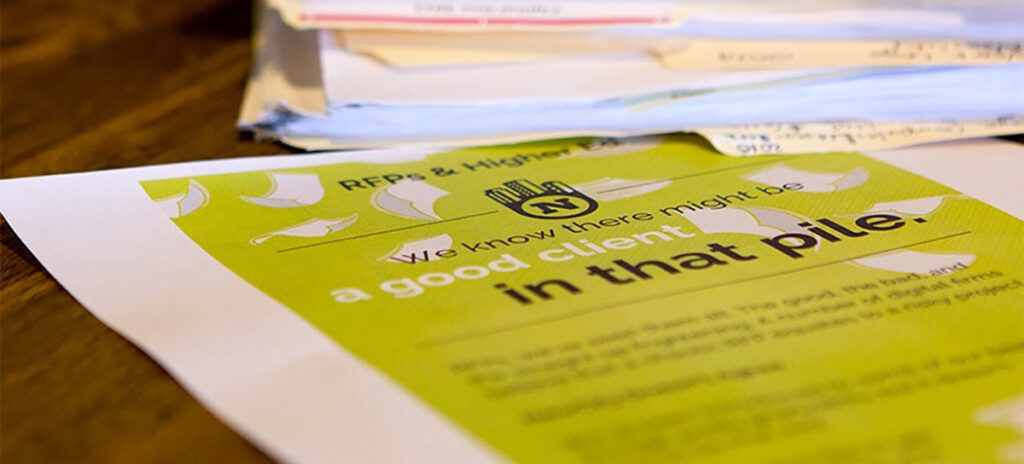As a digital design firm with a strong focus on higher ed and other non-profit work, a lot of our prospective clients are required to issue a formal “Request for Proposal” (RFP) when selecting a web design partner.
That’s a load of…
We probably review and qualify at least a half-dozen RFPs every few weeks. Some are good, some are bad, and some are really, really ugly. That’s OK. It comes with the territory, and we’re set up to manage it.
Fact is, we’ve found some of our favorite clients hiding behind some terrible RFPs. We just needed to have a friendly conversation with them to realize there was actually a really good project hidden in that load of … paper.
Let’s Make it Better
We’d like to help make the process better, so we’re starting this series of articles about RFPs. It’s a big topic, so we’ll approach it in bite-size pieces. This one will help you with the process of finding the right design partner and touches primarily on lead times, resource availability, and setting the stage for a successful selection process.
Please Don’t Do This
One of the most heartbreaking patterns we come across when reviewing RFPs is that the project timelines are far too short.
Sometimes they turn out to be more flexible than the RFP would indicate, but unrealistic dates often remain rigid, and experienced design firms will bow out of the running before taking a project that is compromised from the start. When this happens, well-meaning client teams are left with design firms that overreach to get the job or are too inexperienced to realize the danger.
Or This
In other cases, the project timelines might seem reasonable, but only if the selected firm can put a full project team on it immediately after the project is awarded. If you intend to work with a top-tier firm, odds are their people will not be able to start a new project that quickly.
The truth is, good design firms tend to stay busy, and we do everything in our power to keep our project teams booked as far out as we can. If we’ve done our job securing new work, it could potentially take months before the right team of people is available to kickoff a large-scale web project in earnest.
You might get lucky and find the right design firm with an unexpected hole in their schedule, but why risk it?
How About We Try It This Way?
If your procurement process requires that you issue a formal RFP and you want to select from a strong pool of design firms, here’s our advice:
Take The Time to Get to Know The Firms Out There
Get recommendations, check out their work, talk to some of their clients, and initiate an informal exploratory discussion with a few of them well in advance of your project.
Be As Transparent As You Can
In particular, share specifics about project details and organizational dynamics. Find out how firms would approach your project, how long it might take, and have an open conversation about budget ranges and what you think is feasible.
Send Out Your RFP With a Realistic Selection Timeline
Two to three months is typical (unless only one person is making the decision). Allow plenty of time for Q&As and discussions about scope and requirements. Again, be transparent.
No Spec Work (in strategy or design)
Most reputable firms will not respond to your RFP if you request it.
Wheels Up!
If a presentation is part of the process, build time in to allow for travel plans and proper preparation. Bear in mind, firms are currently hard at work on existing projects and will need to schedule around those.
Kick-Off Buffer Time
Make your selection early enough that your chosen vendor still has two to three months before your desired kickoff. Just as you are evaluating a number of possible design firms, they are evaluating a number of other interesting opportunities. The more flexible you are, the more likely you will end up with the right partner.
Work with them before the project starts to identify some steps you can be taking to get your house in order before the collaborative work begins in earnest. This preparatory work will pay huge dividends as the project proceeds. It will also allow your design firm to review (and improve, if needed) your analytics set-up and begin gathering the baseline data that will help inform subsequent phases of the project. You do have analytics set up, right?
